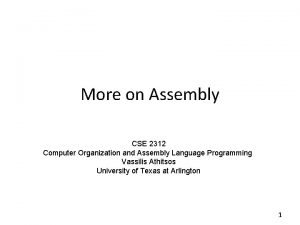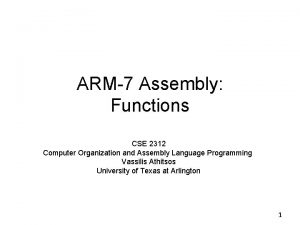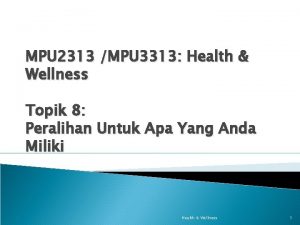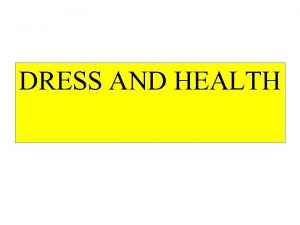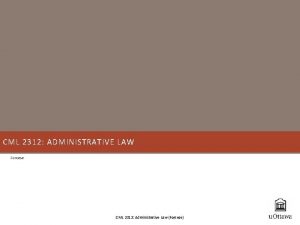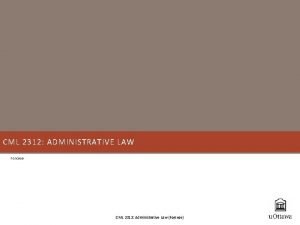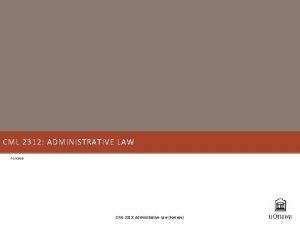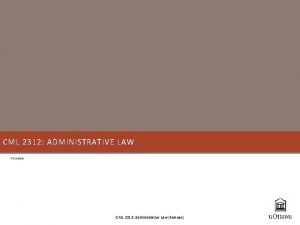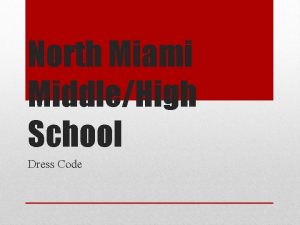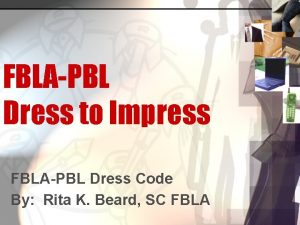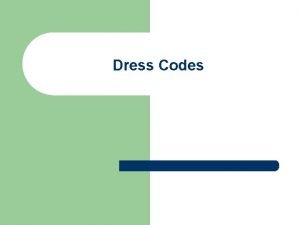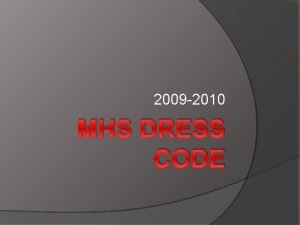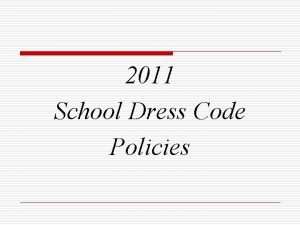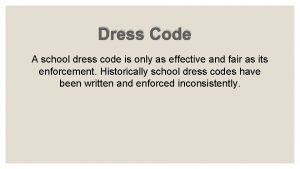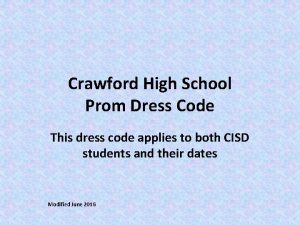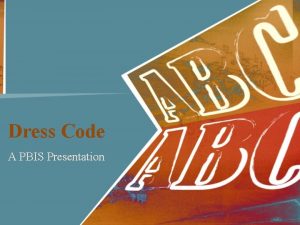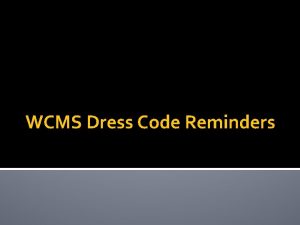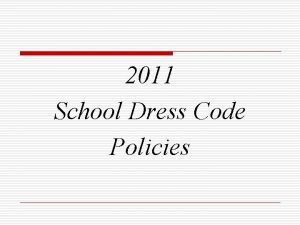Chapter 2 Student Notes Friday 2312 Dress for









































































- Slides: 73

Chapter 2 Student Notes Friday, 2/3/12 Dress for Success for Extra Credit

2. 1 Inductive Reasoning and Conjecture

Conjecture Make a conjecture from the given statement. Given: The toast is burnt. Conjecture: ______________ Given: It is winter. Conjecture: ______________ Given: Angle A is a right angle. Conjecture: ______________

Counterexample Write a counterexample for each conjecture. Conjecture: The sky is blue. Counterexample: ________________ Conjecture: Angle 1 and Angle 2 are congruent. Counterexample: ________________ Conjecture: l and m are parallel Counterexample: ________________

Determine if each conjecture is true or false. Give a counterexample for any false conjecture. 1. Given: A, B, C are collinear. Conjecture: A, B, C are on the same line. 2. Given: 1 is a right angle. Conjecture: m 1 = 90. 3. Given: AB = BC. Conjecture: B is the midpoint of AC. T/F T/F

Determine if each conjecture is true or false. Give a counterexample for any false conjecture. 1. Given: The dog is brown. Conjecture: It is a chocolate lab. T/F 2. Given: 3 and 4 form a linear pair. Conjecture: 3 4 T/F 3. Given: 1 and 2 are complementary Conjecture: m 1 = 45, m 2 = 45. m 1 = 48, m 2 = 42 T/F


2. 2 Logic

Statement �Truth Value – �Negation �Compound Statement –

Conjunction �Symbol for And: Disjunction �Symbol for Or:

Circle the statement that is true. p: Angle A is a right angle. r: Angle A is an obtuse angle. r: Angle A is an acute angle. p q r 2. p q r > > 1. > >

Truth Table �Examples of Truth Tables. p ~p T F F T Disjunction p q T T T F F p >q p q T T T F F p q > Negation Conjunction


2. 3 Conditional Statements

Conditional Statement: A right angle has a measure of 90 degrees. If-then: Statement: A car has four wheels. If-then: Statement: A triangle has 3 sides. If-then:

Parts of a Conditional Statement � Hypothesis � Conclusion If it is a car, then it has four wheels.

Converse Conditional: If it is a car then it has 4 wheels. Converse: Conditional: If it is a pig, then it can fly. Converse: Conditional: If it is a right angle, then it measure 90. Converse:

Inverse Conditional: If it is a car then it has 4 wheels. Inverse: Conditional: If it is a pig, then it can fly. Inverse: Conditional: If it is a right angle, then it measure 90. Inverse:

Contrapositive Conditional: If it is a car, then it has 4 wheels. Contrapositive: Conditional: If it is a pig, then it can fly. Contrapositive: Conditional: If it is a right angle, then it measure 90. Contrapositive:

Identify the converse, inverse and contrapositive of each conditional statement. Determine if each statement is true or false. T / F If you go to WMHS, then you are a hornet. T / F Converse: __________________________ T / F Inverse: __________________________ T / F Contrapositive: ______________________

Identify the converse, inverse and contrapositive of each conditional statement. Determine if each statement is true or false. T / F If it is a right angle, then it measures 90. T / F Converse: __________________________ T / F Inverse: __________________________ T / F Contrapositive: ______________________


2. 4 Deductive Reasoning

Deductive Reasoning -

Law of Detachment 1. 2. 3.

Law of Syllogism 1. 2. 3.

Examples of the Laws of Detachment and Syllogism. �Detachment 1. If it is a triangle, then it has 3 sides. �Syllogism 1. If it is a Jeep, then it has 4 wheel drive.

Determine whether the 3 rd statement is valid based on the given information. If not, write invalid. 1. If it is a dog, then it has 4 legs. 2. Rover is a dog. 3. Rover has 4 legs. Is it valid? Does it follow one of our Laws?

Determine whether the 3 rd statement is valid based on the given information. If not, write invalid. 1. If you are 18 or older, then you are an adult. 2. If you are an adult, then you can vote. 3. If you are 18 or older, then you can vote. Is it valid? Does it follow one of our Laws?

Use the Law of Detachment or the Law of Syllogism to determine if a valid conclusion can be reached. If it can, state it and the law used. If not, write no conclusion. 1. If it is a car, then it has 4 wheels. 2. A Ferrari is a car. 3. _____________ 1. If you go to the store, then you will go to the post office. 2. If you go to the post office, then you will buy stamps. 3. _____________________

Use the Law of Detachment or the Law of Syllogism to determine if a valid conclusion can be reached. If it can, state it and the law used. If not, write no conclusion. 1. If you are in college, then you are at least 18. 2. Pete is in college. 3. _______________ 1. Right angles are congruent. 2. Angle 1 and Angle 2 are congruent. 3. ________________


2. 5 Postulates Postulate – Statement that is accepted without proof.

Postulate 2. 1 - A B

Postulate 2. 2 - A P B C Plane P Plane ABC



Midpoint Theorem - A M B

Determine if each statement is always, sometimes or never true. 1. A, B, and C are collinear. 2. A, B, and C, are coplanar. 3. RST is a right angle. 4. Two planes intersect to form a line. 5. If AB = BC, the B is the midpoint of AC. 6. Vertical angles are adjacent. 7. If B is the midpoint of AC, then AB = BC.

Determine the number of segments that can be drawn connecting each pair of points. 1. 2.


2. 6 Algebraic Proof

Properties �Reflexive: �Symmetric �Transitive �Substitution

Properties �Distribution �Addition / Subtraction �Multiplication / Division

Identify each property that justifies each statement. 1. If 7 = x, then x = 7. 2. If x + 5 = 7, then x = 2 3. If x = 7 and 7 = y, then x = y. 4. If m 1 + m 2 = 180 and m 2 = m 3, then m 1 + m 3 = 180.

Identify each property that justifies each statement. 1. 2 x + 1 = 2 x + 1 2. If x – 6 = 7, then x = 13 3. If 2(x + 3) = 7, then 2 x + 6 = 7. 4. If 2 x = 16, then x = 8.

Given: 2 x – 5 = 13 Prove: x = 9 Statements Reasons 1. _______ 1. ______ 2. _______ 2. ______ 3. _______ 3. ______


Given: 2 x + 1 = 7 3 Statements Prove: x = 10 Reasons 1. 2 x + 1 = 7 3 1. Given 2. _________ 2. _________________ 3. _________ 4. _________


2. 7 Proving Segment Relationships

Ruler Postulate �The points on any line or line segment can be ____________________________ Betweenness of Points �A point can only be between two _____________________ C A B

Segment Addition Postulate If B is between A and C, C B A

Segment Addition Postulate Statements �Make a statement using the previous postulate about each figure. Y M X J R K L XY = JK = T S RS =

Theorem 2. 2 Reflexive Symmetric Transitive

Given: AB XY, AC XZ Prove: BC YZ A B Z Y Reasons Statements 1. AB XY, AC XZ 2. _______ 3. _______ 1. _______ 2. _______ 3. _______ 4. 5. 6. 7. ______________ C ______________ X

O Given: MO PO, MN PR Prove: NO RO R N Statements M Reasons 1. MO PO, MN PR 2. ________ 3. ________ 1. Given 2. _______ 3. _______ 4. 5. 6. 7. ________________ ______________ P


2. 8 Proving Angle Relationships

Angle Addition Postulate If R is in the interior of PQS, then P OR Q 1 R 2 m PQS = S

Make an angle addition postulate statement about each figure. P m MNO = O M N K J M L m JKL =

Supplement Theorem m 1 + m 2 = ____o Complement Theorem 3 4 1 2 If the noncommon sides of two adjacent angles form a right angle, then the angles are complementary. m 3 + m 4 = ____o

Theorem 2. 5 �Reflexive �Symmetric �Transitive

Theorem 2. 6 2 3 1 If m 1 + m 2 = 180 o,

Theorem 2. 7 3 2 1 If m 1 + m 2 = 90 o,

Vertical Angles Theorem 1 4 2 3 �Abbreviation:

Theorem 2. 9

Theorem 2. 10 Theorem 2. 11 Theorem 2. 12 Theorem 2. 13


Find the measure of each numbered angle. 2. 3 and 4 are complementary, m 4 = 48. 1. m 1 = 72 2 1 3 5 4 m 2 = m 3 = m 5 =

Find the measure of each numbered angle. 3. m 6 = x – 5, m 7 = 2 x – 4 6 7 m 6 = m 7 =

Find the measure of each numbered angle. 4. m 8 = 52. 9 8 m 9 =

Find the measure of each numbered angle. 5. 10 and 11 are complementary. 13 11, m 12= 38. m 13 = 12 13 m 11 = 10 11 m 10 =
 Cse 2312
Cse 2312 Cse 2312
Cse 2312 Mpu 2312
Mpu 2312 Facteur g
Facteur g Fspos vägledning för kontinuitetshantering
Fspos vägledning för kontinuitetshantering Novell typiska drag
Novell typiska drag Nationell inriktning för artificiell intelligens
Nationell inriktning för artificiell intelligens Vad står k.r.å.k.a.n för
Vad står k.r.å.k.a.n för Varför kallas perioden 1918-1939 för mellankrigstiden
Varför kallas perioden 1918-1939 för mellankrigstiden En lathund för arbete med kontinuitetshantering
En lathund för arbete med kontinuitetshantering Särskild löneskatt för pensionskostnader
Särskild löneskatt för pensionskostnader Vilotidsbok
Vilotidsbok A gastrica
A gastrica Förklara densitet för barn
Förklara densitet för barn Datorkunskap för nybörjare
Datorkunskap för nybörjare Tack för att ni lyssnade bild
Tack för att ni lyssnade bild Debattinlägg mall
Debattinlägg mall Magnetsjukhus
Magnetsjukhus Nyckelkompetenser för livslångt lärande
Nyckelkompetenser för livslångt lärande Påbyggnader för flakfordon
Påbyggnader för flakfordon Formel för lufttryck
Formel för lufttryck Offentlig förvaltning
Offentlig förvaltning Bo bergman jag fryser om dina händer
Bo bergman jag fryser om dina händer Presentera för publik crossboss
Presentera för publik crossboss Argument för teckenspråk som minoritetsspråk
Argument för teckenspråk som minoritetsspråk Kanaans land
Kanaans land Treserva lathund
Treserva lathund Fimbrietratt
Fimbrietratt Claes martinsson
Claes martinsson Cks
Cks Programskede byggprocessen
Programskede byggprocessen Mat för idrottare
Mat för idrottare Verktyg för automatisering av utbetalningar
Verktyg för automatisering av utbetalningar Rutin för avvikelsehantering
Rutin för avvikelsehantering Smärtskolan kunskap för livet
Smärtskolan kunskap för livet Ministerstyre för och nackdelar
Ministerstyre för och nackdelar Tack för att ni har lyssnat
Tack för att ni har lyssnat Referatmarkering
Referatmarkering Redogör för vad psykologi är
Redogör för vad psykologi är Stål för stötfångarsystem
Stål för stötfångarsystem Atmosfr
Atmosfr Borra hål för knoppar
Borra hål för knoppar Orubbliga rättigheter
Orubbliga rättigheter Relativ standardavvikelse formel
Relativ standardavvikelse formel Tack för att ni har lyssnat
Tack för att ni har lyssnat Steg för steg rita
Steg för steg rita Verksamhetsanalys exempel
Verksamhetsanalys exempel Tobinskatten för och nackdelar
Tobinskatten för och nackdelar Toppslätskivling effekt
Toppslätskivling effekt Modell för handledningsprocess
Modell för handledningsprocess Egg för emanuel
Egg för emanuel Elektronik för barn
Elektronik för barn Klädsel i rom
Klädsel i rom Strategi för svensk viltförvaltning
Strategi för svensk viltförvaltning Kung som dog 1611
Kung som dog 1611 Ellika andolf
Ellika andolf Romarriket tidslinje
Romarriket tidslinje Tack för att ni lyssnade
Tack för att ni lyssnade Multiplikation med decimaltal uppgifter
Multiplikation med decimaltal uppgifter Rim till lärare
Rim till lärare Inköpsprocessen steg för steg
Inköpsprocessen steg för steg Rbk fuktmätning
Rbk fuktmätning Ledarskapsteorier
Ledarskapsteorier Cellorov
Cellorov Myndigheten för delaktighet
Myndigheten för delaktighet Trög för kemist
Trög för kemist Tillitsbaserad ledning
Tillitsbaserad ledning Läkarutlåtande för livränta
Läkarutlåtande för livränta Karttecken brun triangel
Karttecken brun triangel Skapa med geometriska former
Skapa med geometriska former Texter för hinduer tantra
Texter för hinduer tantra Vanlig celldelning
Vanlig celldelning Bris för vuxna
Bris för vuxna Bamse för de yngsta
Bamse för de yngsta
